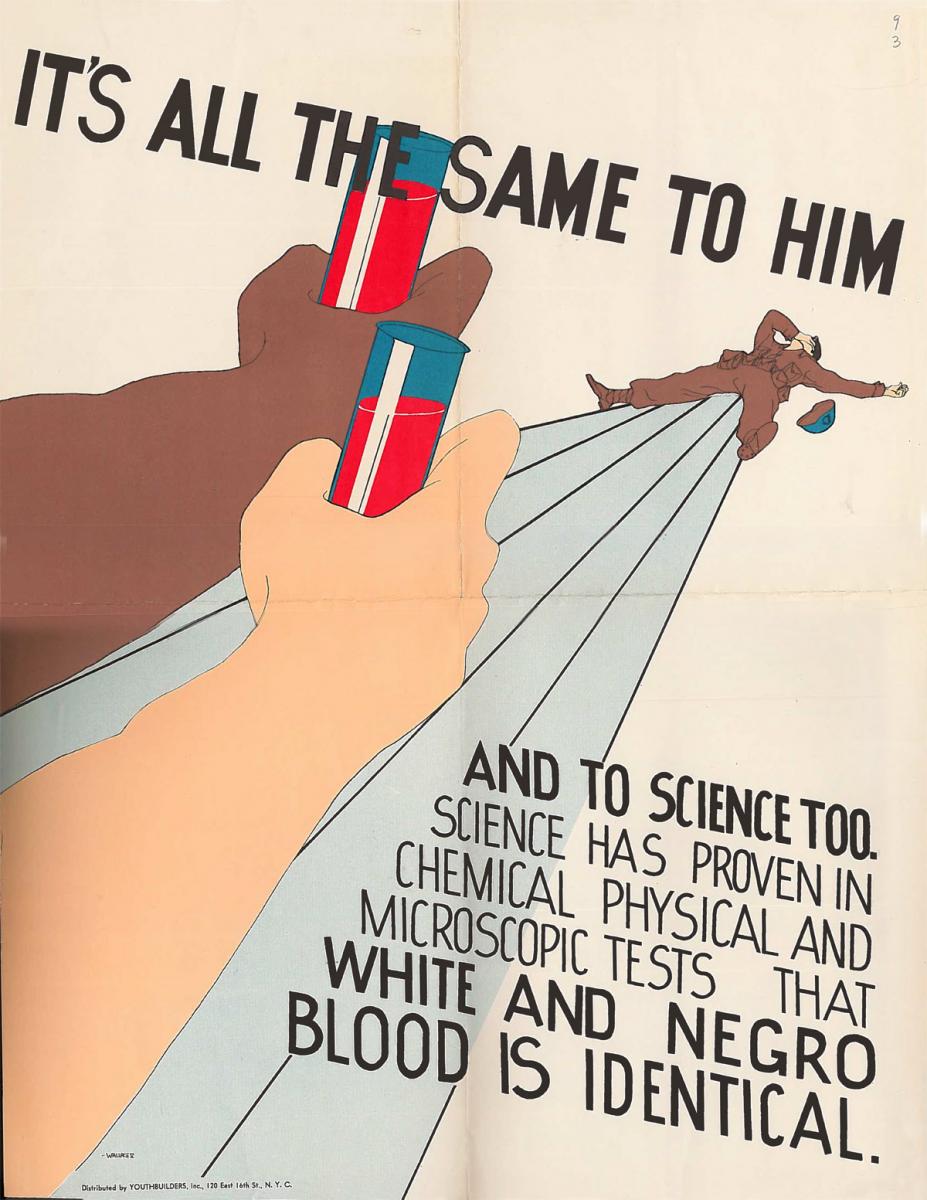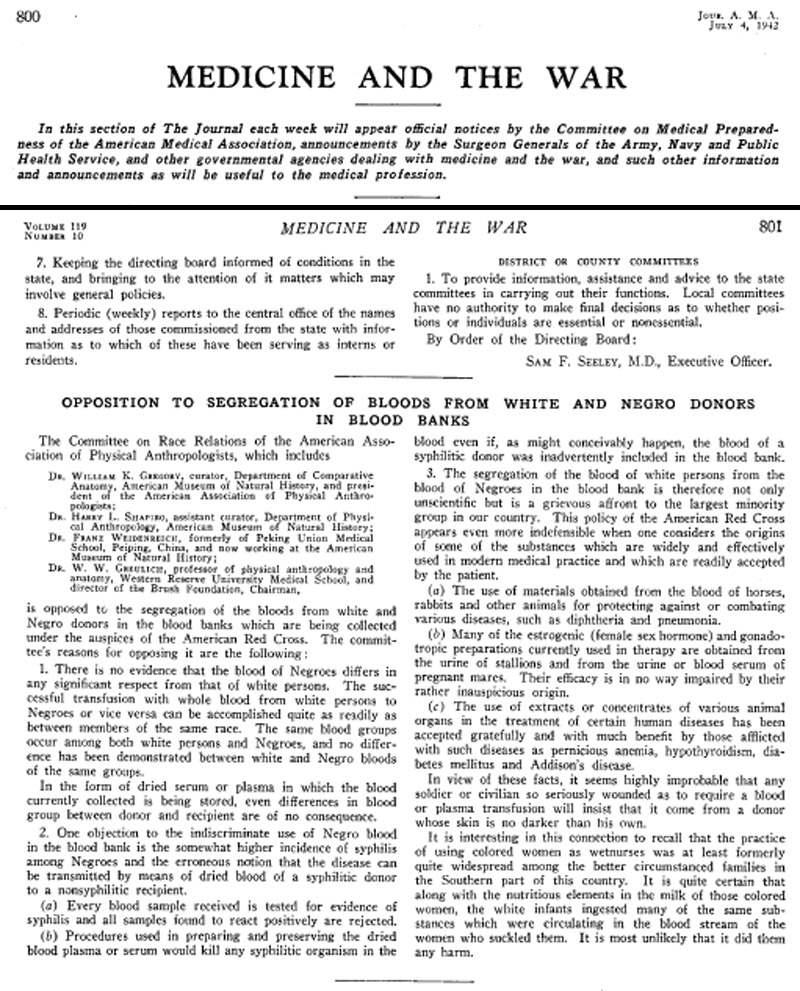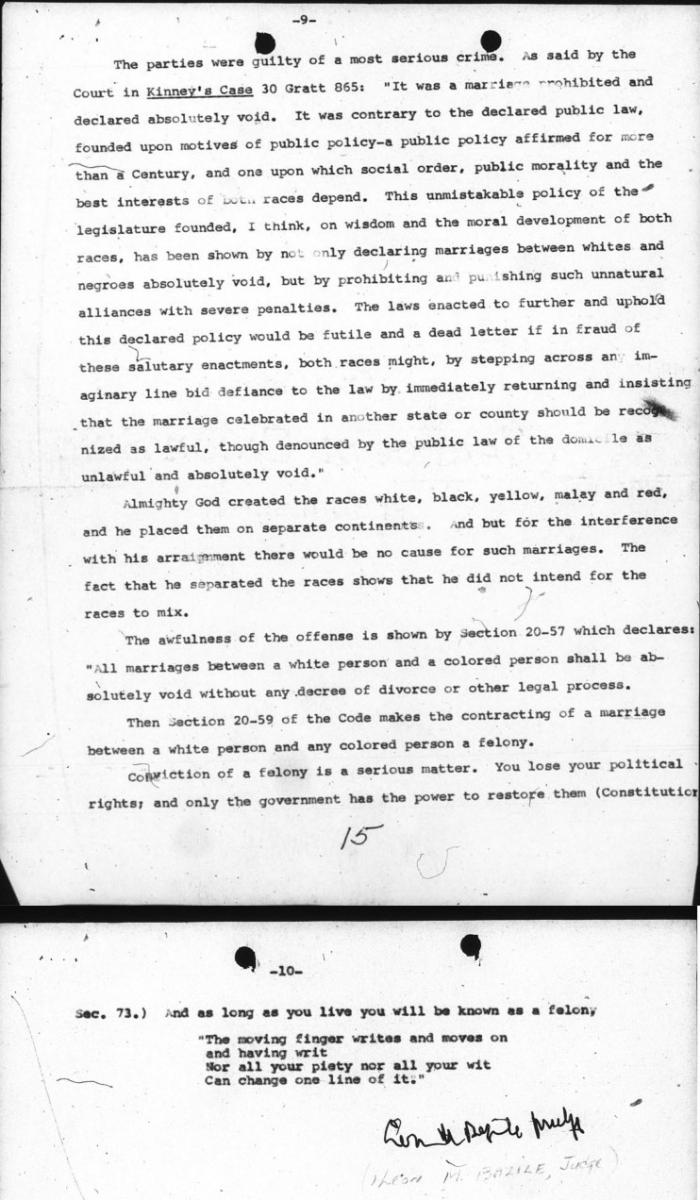 Poster distributed by Youthbuilders, the student group from New York City's PS 43, to protest segregated blood banks. Produced in 1945, reproduced here from the YWCA of the U.S.A. Records, Sophia Smith Collection, Smith College. The poster was distributed along with copies of YWCA’s play “Blood Doesn’t Tell."
Poster distributed by Youthbuilders, the student group from New York City's PS 43, to protest segregated blood banks. Produced in 1945, reproduced here from the YWCA of the U.S.A. Records, Sophia Smith Collection, Smith College. The poster was distributed along with copies of YWCA’s play “Blood Doesn’t Tell."In recent weeks I’ve been simultaneously accused of “whitewashing scientific racism” (by a creationist) and “social-justice breast-beating” for blaming “black religionists’ rejection of evolution on the racism of scientists” (by an evolutionary biologist, though I actually had written “racism in science”). Both can’t be right, and indeed neither is, but that’s not the point. Understanding why both are wrong will illuminate some common creationist misconceptions, and hopefully reveal some pathways that science communicators might find useful in outreach to African American audiences.
The most recent incident comes from the Discovery Institute’s response to my recent story about the desegregation of blood banks and the role science students played in that struggle. The Disco. ‘tute writer objected to my claim that the ban on black blood donations, and later segregation of the blood supply, were not supported by science. Various creationist groups, including the Disco. ‘tute, are in the habit of claiming that racism is a result of evolutionary ideas, and that science advanced racism by endorsing evolution. In particular, the ‘tute claims that anyone who opposed blood segregation in the ‘40s “were the ‘science deniers’ of their day” [emphasis from the original]. This is false, and the example at hand shows that falsehood quite clearly.
In the original piece, I quoted the Army’s surgeon general, who explained that the ban on black blood donation was “[f]or reasons not biologically convincing but which are commonly recognized as psychologically important in America.” I mentioned that some blood banks simply ignored the segregation order, and that “[m]edical and scientific societies joined with civil rights groups in protesting the policy.”
 The most prominent example of that opposition came from the American Association of Physical Anthropologists, whose Committee on Race Relations issued a strong statement opposing blood segregation. That resolution was reprinted in full in the Journal of the American Medical Association (under the title “Opposition to Segregation of Bloods from White and Negro Donors in Blood Banks”) and in Science (under the title “The Segregation of Bloods”); both leading journals presented it prominently and without any indication of scientific dispute. Scientific American covered the statement as well, in October 1942, under the title “Not Scientific: Aversion to Non-Caucasian Blood is Emotional, Not Factual.” The unsigned article notes the announcement in JAMA, and observes that “the aversion [of white people to being given blood from African Americans] perhaps represents the persistence of ancient folklore that one’s personality is closely associated with one’s blood. Frequently used clichés, such as ‘noble blood,’ are remnants remaining in the language from a day when such superstitions were more prevalent than now.”
The most prominent example of that opposition came from the American Association of Physical Anthropologists, whose Committee on Race Relations issued a strong statement opposing blood segregation. That resolution was reprinted in full in the Journal of the American Medical Association (under the title “Opposition to Segregation of Bloods from White and Negro Donors in Blood Banks”) and in Science (under the title “The Segregation of Bloods”); both leading journals presented it prominently and without any indication of scientific dispute. Scientific American covered the statement as well, in October 1942, under the title “Not Scientific: Aversion to Non-Caucasian Blood is Emotional, Not Factual.” The unsigned article notes the announcement in JAMA, and observes that “the aversion [of white people to being given blood from African Americans] perhaps represents the persistence of ancient folklore that one’s personality is closely associated with one’s blood. Frequently used clichés, such as ‘noble blood,’ are remnants remaining in the language from a day when such superstitions were more prevalent than now.”
Science, JAMA, Scientific American, and the AAPA were all in agreement with the Army’s surgeon general that blood did not exhibit meaningful racial variation, and that blood transfusions across races were safe. If those were the science deniers of the day, it isn’t clear who the ‘tute thinks represented the real voice of science!
 Indeed, the strongest exponents of race theory in the 19th and early 20th century, and segregation’s greatest defenders, generally opposed evolution. Consider Houston Stewart Chamberlain, one of two leading race theorists of the 19th century (PDF), whose writings exerted great influence over, among others, Adolf Hitler (who borrowed Chamberlain’s phrase “struggle [Kampf] for existence” rather notably). Chamberlain called Darwin’s ideas “unproven and unprovable” and “pseudo-scientific phantasy,” and declared Darwinian evolution a “hair-raising absurdity [that] poisons not only natural science but the whole of human thought.” A century later, when Judge Leon Bazile sought to explain why the Lovings’ interracial marriage could not be recognized by the state of Virginia in 1958 (a ruling overturned in 1969), he didn’t turn to science, but creationism: “Almighty God created the races white, black, yellow, malay and red, and he placed them on separate continents. And but for the interference with his arrangement there would be no cause for such marriages. The fact that he separated the races shows that he did not intend for the races to mix.”
Indeed, the strongest exponents of race theory in the 19th and early 20th century, and segregation’s greatest defenders, generally opposed evolution. Consider Houston Stewart Chamberlain, one of two leading race theorists of the 19th century (PDF), whose writings exerted great influence over, among others, Adolf Hitler (who borrowed Chamberlain’s phrase “struggle [Kampf] for existence” rather notably). Chamberlain called Darwin’s ideas “unproven and unprovable” and “pseudo-scientific phantasy,” and declared Darwinian evolution a “hair-raising absurdity [that] poisons not only natural science but the whole of human thought.” A century later, when Judge Leon Bazile sought to explain why the Lovings’ interracial marriage could not be recognized by the state of Virginia in 1958 (a ruling overturned in 1969), he didn’t turn to science, but creationism: “Almighty God created the races white, black, yellow, malay and red, and he placed them on separate continents. And but for the interference with his arrangement there would be no cause for such marriages. The fact that he separated the races shows that he did not intend for the races to mix.”
Poking around in this history at my prompting, Scientific American’s Steve Mirsky found a fascinating article from 1925, arguing that race was a baseless concept (and especially a flawed basis for immigration policy). The author, an associate editor for Scientific American, cited three reasons:
The first is that there is no such thing in the modern world as a pure-bred race. The “pure Nordic” idea is a myth.
The second is that not one scrap of real evidence exists to prove that any one race is potentially abler or more honest or more intelligent than any other race. The “white man’s burden” may be laid down any time with a clear conscience and with no fear that we are deserting our duty to the world.
The third is that racial mixture—even to what we would shrink from as extremes—seems much more likely to be beneficial to civilization than the reverse.
These are surprisingly modern arguments against the concept of race, presented as mainstream science 90 years ago. (And, it should be said, the public response was not uniformly favorable: “One writer who holds an official position in Washington” concluded his reply by asserting, “This is our country. We stole it from the Indians. If any other race wants it they have got to steal it from us.” Another response, however, is more favorable: “The reason I was so gratified to read your article is because I had some controversy some years ago when the ‘eugenics’ fad was at its height,” a reminder that eugenics was by no means a monolith within science, and was already dismissed as a fad by the mid-‘20s. This, too, is a hole in the Disco. ‘tute story.)
The idea of discrete races traces back to a pre-Darwinian essentialism that became untenable by the 19th century, usually justified (and using terminology derived from) the Genesis tale of the dispersal of Noah’s sons (Japheth to Europe and Asia, Shem to the Middle East and the Semitic peoples, and sin-stained Ham to Africa). Clearly, that notion was under scientific assault by the ’20s. By the ’40s, the idea of blood segregation was widely rejected by doctors and scientists. That’s the truth, not a whitewash, and it should be celebrated.
That doesn’t mean that those doctors and scientists were angels. The AMA permitted local chapters to be racially segregated until the 1960s. Doctors took part in the grossly unethical and racist Tuskegee experiments, and other similarly racist experiments and policies across the country and around the world. The AAPA and other anthropology bodies did their share to promote the concept of race, and relied on racism to justify various research practices, including stealing artifacts from native cultures for study in museums. Even today we see that legacy in debates about whether astronomers ought to be allowed to construct a telescope on one of native Hawaiians’ most sacred sites, bulldozing and limiting access to Mauna Kea for a new observatory.
Much of this racism was probably accidental or unconsidered. Scientists are products of their society, and while some are laudably forward-thinking, most are predictably trapped by prevailing assumptions. While Darwin’s views on race, for instance, were fairly progressive for the time, he talked about race in ways, and made racial assumptions, that would be unacceptable and untenable today. The same is true of early human geneticists, anthropologists, and medical researchers. We can acknowledge that and still celebrate these researchers’ accomplishments.
As Rebecca Skloot observed in her marvelous The Immortal Life of Henrietta Lacks, the general disenfranchisement of African Americans disconnected them especially from science and medicine, and doctors of the day had no compunction about stealing parts of their bodies without permission for medical research (and passing the resulting cell line off as having come from a white woman by a different name). This is not some distant past, but the 1950s, the birth of modern biomedical science.
Whether or not scientists endorsed blood segregation, it’s reasonable that the African American community would see it through a lens of scientific discrimination. To anyone of any race who didn’t read scientific journals, the segregation policy would be seen as a claim about racial inferiority, and that’s the level on which the students of New York’s PS 43 addressed it, as do the fictional students in the YWCA play “Blood Doesn’t Tell” (both discussed in the previous post).
That history goes deeper. From the early 19th century on, whites in Baltimore would tell the black community (free and enslaved) stories about “night doctors,” medical students and researchers from Johns Hopkins who, dressed in white hoods and gowns, would prey on any African American they came across, dragging them back to campus for gruesome experiments. (That same costume was later adopted, to inspire the same fear, by the Knights of the Ku Klux Klan.) Blacks were warned to stay in at night, and away from the university and its medical facilities. When Rebecca Skloot interviewed black Baltimoreans in 2000, she still heard those tales: "John Hopkins was known for experimentin on black folks. They'd snatch em off the street."
Such appropriation of the trappings of science was common. Defenders of slavery argued, with no scientific basis, that only Africans could perform hard manual labor in the grueling heat of the southern US. Phrenologists and others at least pretending to scientific status used skull measurements to claim that racial hierarchy was a matter of nature, not culture. The open racism espoused by James Watson, and racism advanced under scientific guise in documents like The Bell Curve, are modern iterations of the same legacy. It’s not a problem that’s just in our past.
That context matters when we try to teach or otherwise communicate science across racial boundaries. I pointed this out in the spring, discussing patterns in the average views of various religious groups in the US pertaining to evolution and environmental regulation. I commented that African American churches showed little support for either topic, and suggested that one way to address that gap might be:
an acknowledgment of racism in science, both historically and in its current practice. While science is not itself racist, and neither is evolution, both have been tainted by and abused for the benefit of racism, and the African American community has cause for its ambivalence. Those of us who love evolution, love science, and want to share that love with our brothers and sisters of all races and religions need to find better ways to bridge these gaps.
Jerry Coyne, who objects generally to the idea that science and religion could find any way to coexist, specifically singled out that passage out for criticism, claiming that the problem was simply that:
The social dysfunction of many black communities has led them to cling tightly to traditional religion, for, as we know, there’s a strong negative correlation between “successful societies” and religiosity. And that belief is “traditional,” both because many blacks took their religion from the South, where they were enslaved, and because that form of belief offers the most tangible rewards in the hereafter to those who suffer in the present.
This is a bizarre twisting of the history of the black church, ignoring the powerful role the church played in the African American struggle for liberation in the era of slavery, Jim Crow, and today. It rewrites history to make one of the few institutions African Americans could control and use to create stability and independence into an instrument of dependence and dysfunction. And it seems to ignore the possibility that "the dysfunction of black communities" might have been imposed on them by centuries of public policy (some justified by invocations of science).
He added that any claim that science’s history of racism might still be a factor was “social-justice breast-beating,” since:
It’s just disingenuous to claim that blacks reject evolution and environmental controls because they think that science has been tainted by racism…indeed, some scientists have been racist; and eugenics as well as the Tuskegee Study were shameful episodes in the history of genetics and medicine. But if Rosenau thinks that if we scientists admit and decry that earlier racism (which we’ve done—repeatedly), then blacks will suddenly embrace evolution and become environmentalists, I’ve got a bridge in Riyadh to sell him.
Look, we can move past wondering whether African Americans “think” that science has been tainted by racism. As Coyne goes on to acknowledge, it totally has been. Will merely acknowledging and criticizing such racism bridge racial divides on evolution or the environment? Surely not on its own, but it’s hard to imagine progress without that first step. And as Coyne fails to acknowledge, science is still tainted by racism. And that matters. We see that in the deficit of African Americans in science classrooms, and we see it in public polls. Asked whether “Modern science does more harm than good,” only 14% of white Americans agree, but twice as many African Americans agree (25%). Asked if “We trust too much in science,” African Americans are again twice as distrustful (51% agree, compared to 28% of whites).
To pretend that past and present racism in science plays no role in that gap is absurd. To pretend that science has fully grappled with its past and present racism, fully made amends, and can move forward with a clean slate, is absurd. The fact that so many African Americans are distrustful of science has real consequences, making society weaker and threatening the wellbeing of African Americans. It leaves African Americans underrepresented in STEM careers, which are often held out as the jobs of the future. Scientists and science communicators owe it to ourselves and our brothers and sisters of all races to confront this problem. The first step has to be acknowledging that it exists, and to explore ways (as with blood segregation) that science has fought back against racism.

